Detailed Marketing Plan: Adidas Ultra Boost Product Analysis
VerifiedAdded on 2022/03/19
|19
|4991
|47
Report
AI Summary
This report presents a comprehensive marketing plan for Adidas, focusing on the Ultra Boost product line. It begins with an executive summary and current situation analysis, assessing current demand, customer profiles, market size, and competitive landscape, including products, distribution channels, pricing, promotion, and market share. The report then conducts a SWOT analysis, identifying strengths, weaknesses, opportunities, and threats. Following this, it outlines the marketing objectives, strategy, and barriers to entry. The action program details the marketing mix, including product, price, promotion, and distribution channel strategies. The plan highlights Adidas's position in the footwear industry, its customer segmentation, and its approach to competition, providing a thorough analysis of its marketing environment and strategic recommendations for future growth.
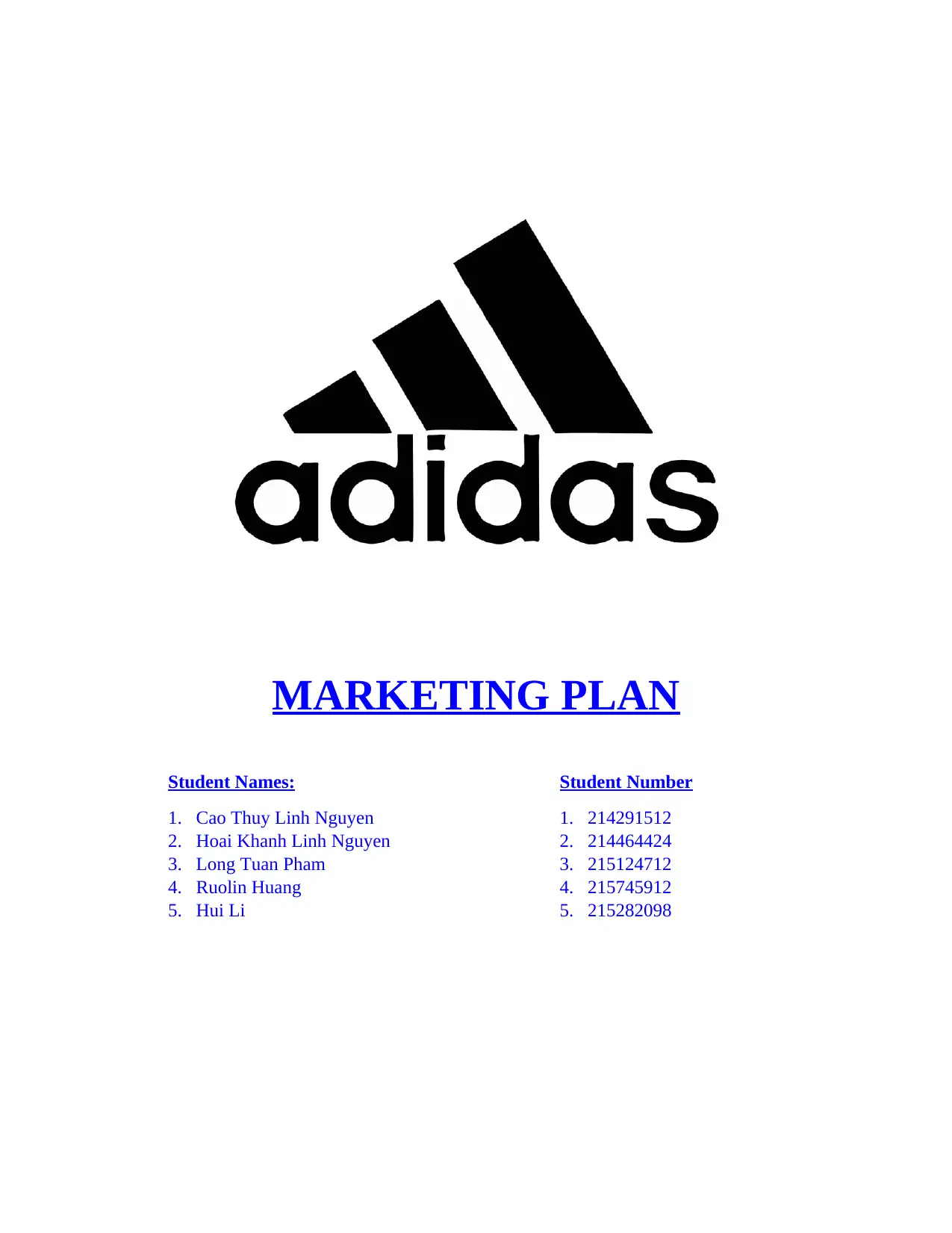
MARKETING PLAN
Student Names:
1. Cao Thuy Linh Nguyen
2. Hoai Khanh Linh Nguyen
3. Long Tuan Pham
4. Ruolin Huang
5. Hui Li
Student Number
1. 214291512
2. 214464424
3. 215124712
4. 215745912
5. 215282098
Student Names:
1. Cao Thuy Linh Nguyen
2. Hoai Khanh Linh Nguyen
3. Long Tuan Pham
4. Ruolin Huang
5. Hui Li
Student Number
1. 214291512
2. 214464424
3. 215124712
4. 215745912
5. 215282098
Paraphrase This Document
Need a fresh take? Get an instant paraphrase of this document with our AI Paraphraser
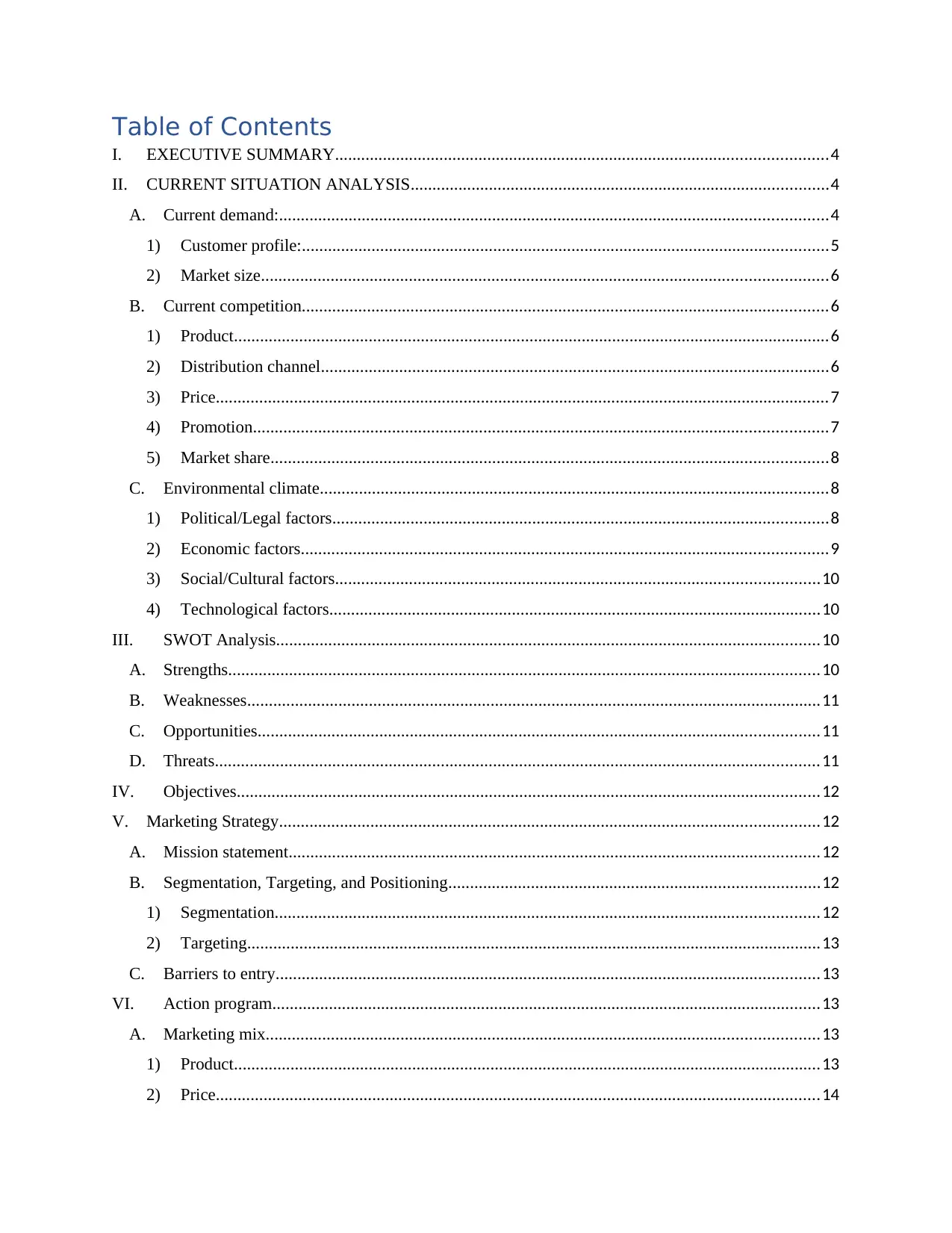
Table of Contents
I. EXECUTIVE SUMMARY.................................................................................................................4
II. CURRENT SITUATION ANALYSIS................................................................................................4
A. Current demand:..............................................................................................................................4
1) Customer profile:.........................................................................................................................5
2) Market size..................................................................................................................................6
B. Current competition.........................................................................................................................6
1) Product.........................................................................................................................................6
2) Distribution channel.....................................................................................................................6
3) Price.............................................................................................................................................7
4) Promotion....................................................................................................................................7
5) Market share................................................................................................................................8
C. Environmental climate.....................................................................................................................8
1) Political/Legal factors..................................................................................................................8
2) Economic factors.........................................................................................................................9
3) Social/Cultural factors...............................................................................................................10
4) Technological factors.................................................................................................................10
III. SWOT Analysis.............................................................................................................................10
A. Strengths........................................................................................................................................10
B. Weaknesses....................................................................................................................................11
C. Opportunities.................................................................................................................................11
D. Threats...........................................................................................................................................11
IV. Objectives......................................................................................................................................12
V. Marketing Strategy............................................................................................................................12
A. Mission statement..........................................................................................................................12
B. Segmentation, Targeting, and Positioning.....................................................................................12
1) Segmentation.............................................................................................................................12
2) Targeting....................................................................................................................................13
C. Barriers to entry.............................................................................................................................13
VI. Action program..............................................................................................................................13
A. Marketing mix...............................................................................................................................13
1) Product.......................................................................................................................................13
2) Price...........................................................................................................................................14
I. EXECUTIVE SUMMARY.................................................................................................................4
II. CURRENT SITUATION ANALYSIS................................................................................................4
A. Current demand:..............................................................................................................................4
1) Customer profile:.........................................................................................................................5
2) Market size..................................................................................................................................6
B. Current competition.........................................................................................................................6
1) Product.........................................................................................................................................6
2) Distribution channel.....................................................................................................................6
3) Price.............................................................................................................................................7
4) Promotion....................................................................................................................................7
5) Market share................................................................................................................................8
C. Environmental climate.....................................................................................................................8
1) Political/Legal factors..................................................................................................................8
2) Economic factors.........................................................................................................................9
3) Social/Cultural factors...............................................................................................................10
4) Technological factors.................................................................................................................10
III. SWOT Analysis.............................................................................................................................10
A. Strengths........................................................................................................................................10
B. Weaknesses....................................................................................................................................11
C. Opportunities.................................................................................................................................11
D. Threats...........................................................................................................................................11
IV. Objectives......................................................................................................................................12
V. Marketing Strategy............................................................................................................................12
A. Mission statement..........................................................................................................................12
B. Segmentation, Targeting, and Positioning.....................................................................................12
1) Segmentation.............................................................................................................................12
2) Targeting....................................................................................................................................13
C. Barriers to entry.............................................................................................................................13
VI. Action program..............................................................................................................................13
A. Marketing mix...............................................................................................................................13
1) Product.......................................................................................................................................13
2) Price...........................................................................................................................................14

3) Promotion..................................................................................................................................14
4) Distribution channel...................................................................................................................15
Bibliography..............................................................................................................................................17
4) Distribution channel...................................................................................................................15
Bibliography..............................................................................................................................................17
⊘ This is a preview!⊘
Do you want full access?
Subscribe today to unlock all pages.

Trusted by 1+ million students worldwide
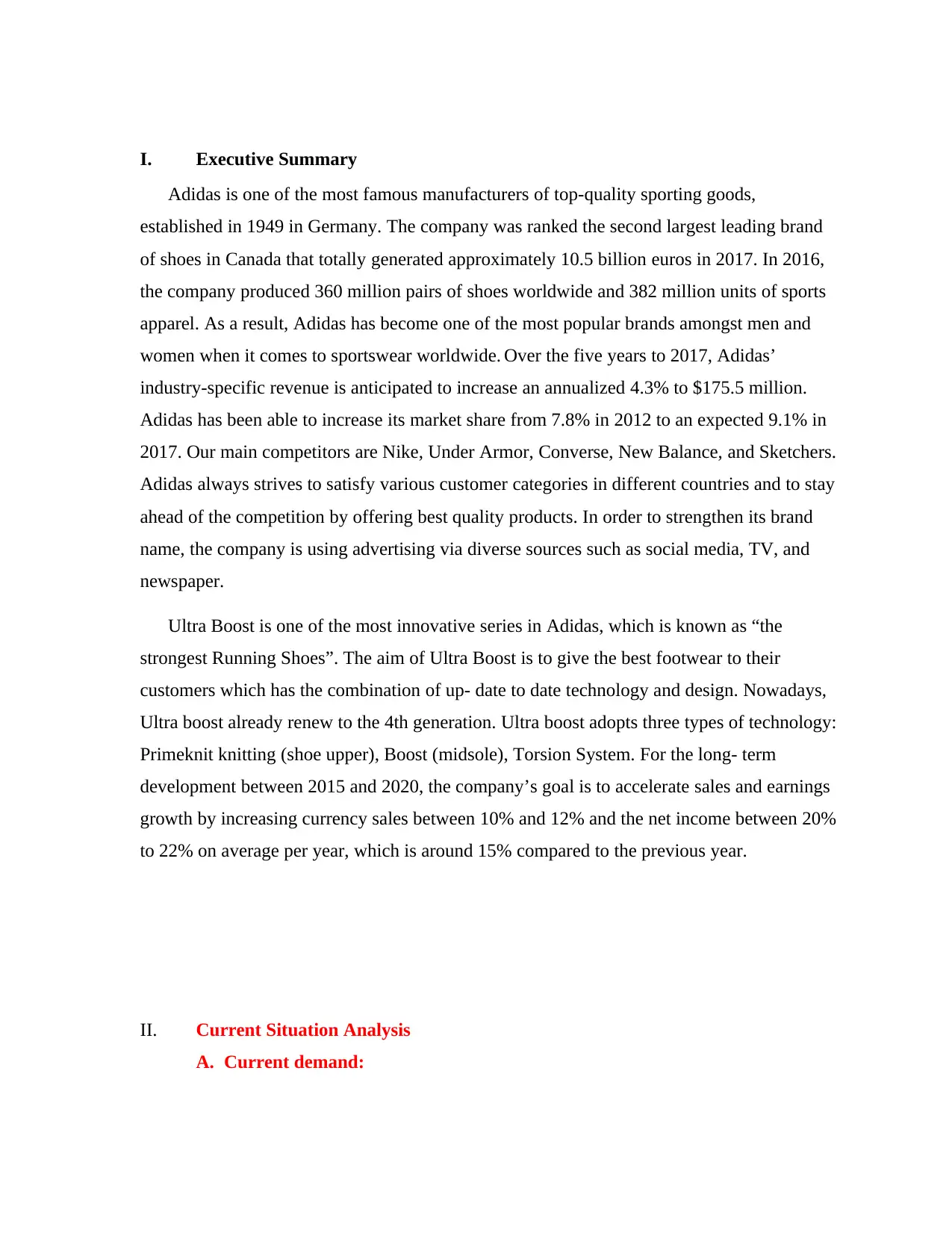
I. Executive Summary
Adidas is one of the most famous manufacturers of top-quality sporting goods,
established in 1949 in Germany. The company was ranked the second largest leading brand
of shoes in Canada that totally generated approximately 10.5 billion euros in 2017. In 2016,
the company produced 360 million pairs of shoes worldwide and 382 million units of sports
apparel. As a result, Adidas has become one of the most popular brands amongst men and
women when it comes to sportswear worldwide. Over the five years to 2017, Adidas’
industry-specific revenue is anticipated to increase an annualized 4.3% to $175.5 million.
Adidas has been able to increase its market share from 7.8% in 2012 to an expected 9.1% in
2017. Our main competitors are Nike, Under Armor, Converse, New Balance, and Sketchers.
Adidas always strives to satisfy various customer categories in different countries and to stay
ahead of the competition by offering best quality products. In order to strengthen its brand
name, the company is using advertising via diverse sources such as social media, TV, and
newspaper.
Ultra Boost is one of the most innovative series in Adidas, which is known as “the
strongest Running Shoes”. The aim of Ultra Boost is to give the best footwear to their
customers which has the combination of up- date to date technology and design. Nowadays,
Ultra boost already renew to the 4th generation. Ultra boost adopts three types of technology:
Primeknit knitting (shoe upper), Boost (midsole), Torsion System. For the long- term
development between 2015 and 2020, the company’s goal is to accelerate sales and earnings
growth by increasing currency sales between 10% and 12% and the net income between 20%
to 22% on average per year, which is around 15% compared to the previous year.
II. Current Situation Analysis
A. Current demand:
Adidas is one of the most famous manufacturers of top-quality sporting goods,
established in 1949 in Germany. The company was ranked the second largest leading brand
of shoes in Canada that totally generated approximately 10.5 billion euros in 2017. In 2016,
the company produced 360 million pairs of shoes worldwide and 382 million units of sports
apparel. As a result, Adidas has become one of the most popular brands amongst men and
women when it comes to sportswear worldwide. Over the five years to 2017, Adidas’
industry-specific revenue is anticipated to increase an annualized 4.3% to $175.5 million.
Adidas has been able to increase its market share from 7.8% in 2012 to an expected 9.1% in
2017. Our main competitors are Nike, Under Armor, Converse, New Balance, and Sketchers.
Adidas always strives to satisfy various customer categories in different countries and to stay
ahead of the competition by offering best quality products. In order to strengthen its brand
name, the company is using advertising via diverse sources such as social media, TV, and
newspaper.
Ultra Boost is one of the most innovative series in Adidas, which is known as “the
strongest Running Shoes”. The aim of Ultra Boost is to give the best footwear to their
customers which has the combination of up- date to date technology and design. Nowadays,
Ultra boost already renew to the 4th generation. Ultra boost adopts three types of technology:
Primeknit knitting (shoe upper), Boost (midsole), Torsion System. For the long- term
development between 2015 and 2020, the company’s goal is to accelerate sales and earnings
growth by increasing currency sales between 10% and 12% and the net income between 20%
to 22% on average per year, which is around 15% compared to the previous year.
II. Current Situation Analysis
A. Current demand:
Paraphrase This Document
Need a fresh take? Get an instant paraphrase of this document with our AI Paraphraser
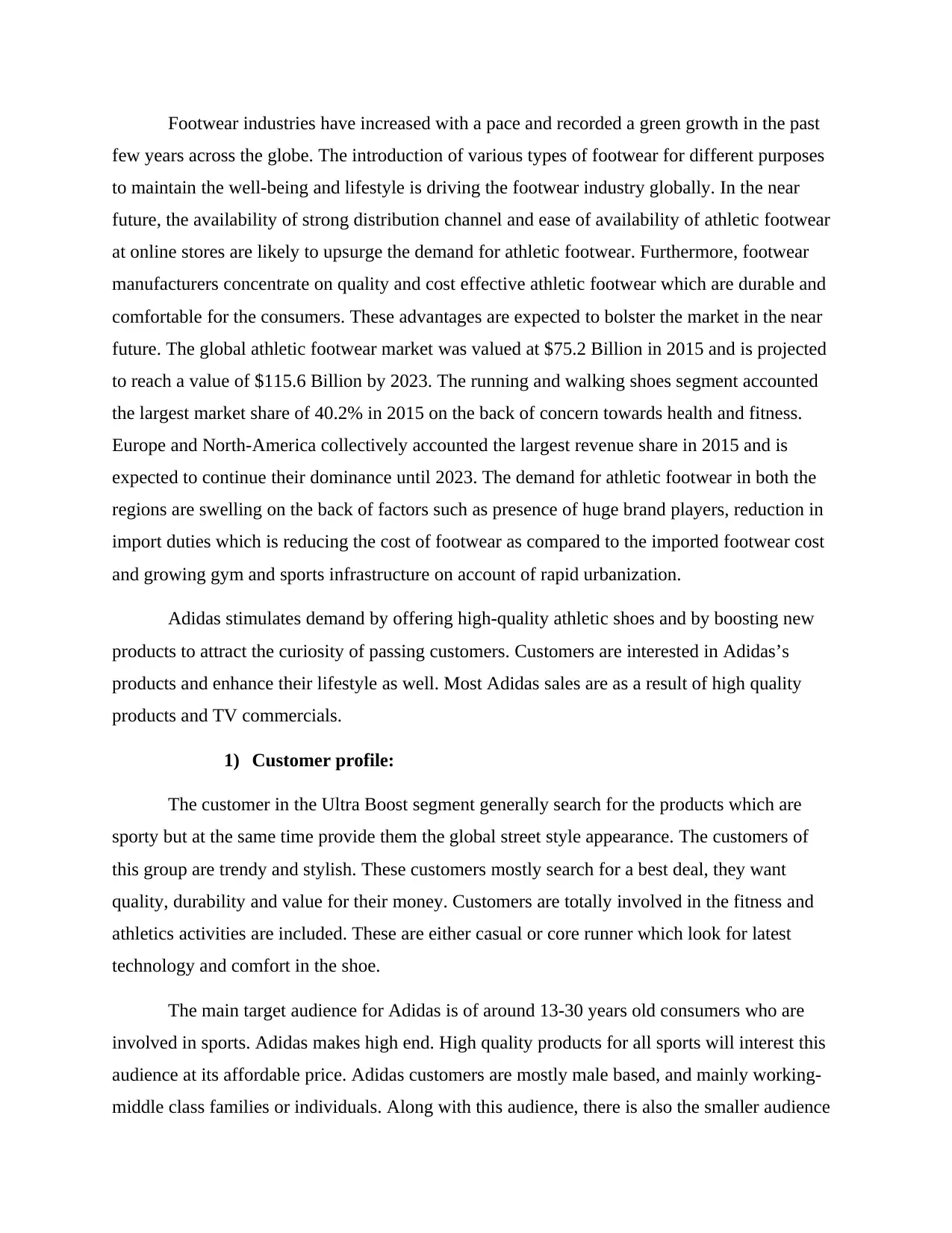
Footwear industries have increased with a pace and recorded a green growth in the past
few years across the globe. The introduction of various types of footwear for different purposes
to maintain the well-being and lifestyle is driving the footwear industry globally. In the near
future, the availability of strong distribution channel and ease of availability of athletic footwear
at online stores are likely to upsurge the demand for athletic footwear. Furthermore, footwear
manufacturers concentrate on quality and cost effective athletic footwear which are durable and
comfortable for the consumers. These advantages are expected to bolster the market in the near
future. The global athletic footwear market was valued at $75.2 Billion in 2015 and is projected
to reach a value of $115.6 Billion by 2023. The running and walking shoes segment accounted
the largest market share of 40.2% in 2015 on the back of concern towards health and fitness.
Europe and North-America collectively accounted the largest revenue share in 2015 and is
expected to continue their dominance until 2023. The demand for athletic footwear in both the
regions are swelling on the back of factors such as presence of huge brand players, reduction in
import duties which is reducing the cost of footwear as compared to the imported footwear cost
and growing gym and sports infrastructure on account of rapid urbanization.
Adidas stimulates demand by offering high-quality athletic shoes and by boosting new
products to attract the curiosity of passing customers. Customers are interested in Adidas’s
products and enhance their lifestyle as well. Most Adidas sales are as a result of high quality
products and TV commercials.
1) Customer profile:
The customer in the Ultra Boost segment generally search for the products which are
sporty but at the same time provide them the global street style appearance. The customers of
this group are trendy and stylish. These customers mostly search for a best deal, they want
quality, durability and value for their money. Customers are totally involved in the fitness and
athletics activities are included. These are either casual or core runner which look for latest
technology and comfort in the shoe.
The main target audience for Adidas is of around 13-30 years old consumers who are
involved in sports. Adidas makes high end. High quality products for all sports will interest this
audience at its affordable price. Adidas customers are mostly male based, and mainly working-
middle class families or individuals. Along with this audience, there is also the smaller audience
few years across the globe. The introduction of various types of footwear for different purposes
to maintain the well-being and lifestyle is driving the footwear industry globally. In the near
future, the availability of strong distribution channel and ease of availability of athletic footwear
at online stores are likely to upsurge the demand for athletic footwear. Furthermore, footwear
manufacturers concentrate on quality and cost effective athletic footwear which are durable and
comfortable for the consumers. These advantages are expected to bolster the market in the near
future. The global athletic footwear market was valued at $75.2 Billion in 2015 and is projected
to reach a value of $115.6 Billion by 2023. The running and walking shoes segment accounted
the largest market share of 40.2% in 2015 on the back of concern towards health and fitness.
Europe and North-America collectively accounted the largest revenue share in 2015 and is
expected to continue their dominance until 2023. The demand for athletic footwear in both the
regions are swelling on the back of factors such as presence of huge brand players, reduction in
import duties which is reducing the cost of footwear as compared to the imported footwear cost
and growing gym and sports infrastructure on account of rapid urbanization.
Adidas stimulates demand by offering high-quality athletic shoes and by boosting new
products to attract the curiosity of passing customers. Customers are interested in Adidas’s
products and enhance their lifestyle as well. Most Adidas sales are as a result of high quality
products and TV commercials.
1) Customer profile:
The customer in the Ultra Boost segment generally search for the products which are
sporty but at the same time provide them the global street style appearance. The customers of
this group are trendy and stylish. These customers mostly search for a best deal, they want
quality, durability and value for their money. Customers are totally involved in the fitness and
athletics activities are included. These are either casual or core runner which look for latest
technology and comfort in the shoe.
The main target audience for Adidas is of around 13-30 years old consumers who are
involved in sports. Adidas makes high end. High quality products for all sports will interest this
audience at its affordable price. Adidas customers are mostly male based, and mainly working-
middle class families or individuals. Along with this audience, there is also the smaller audience
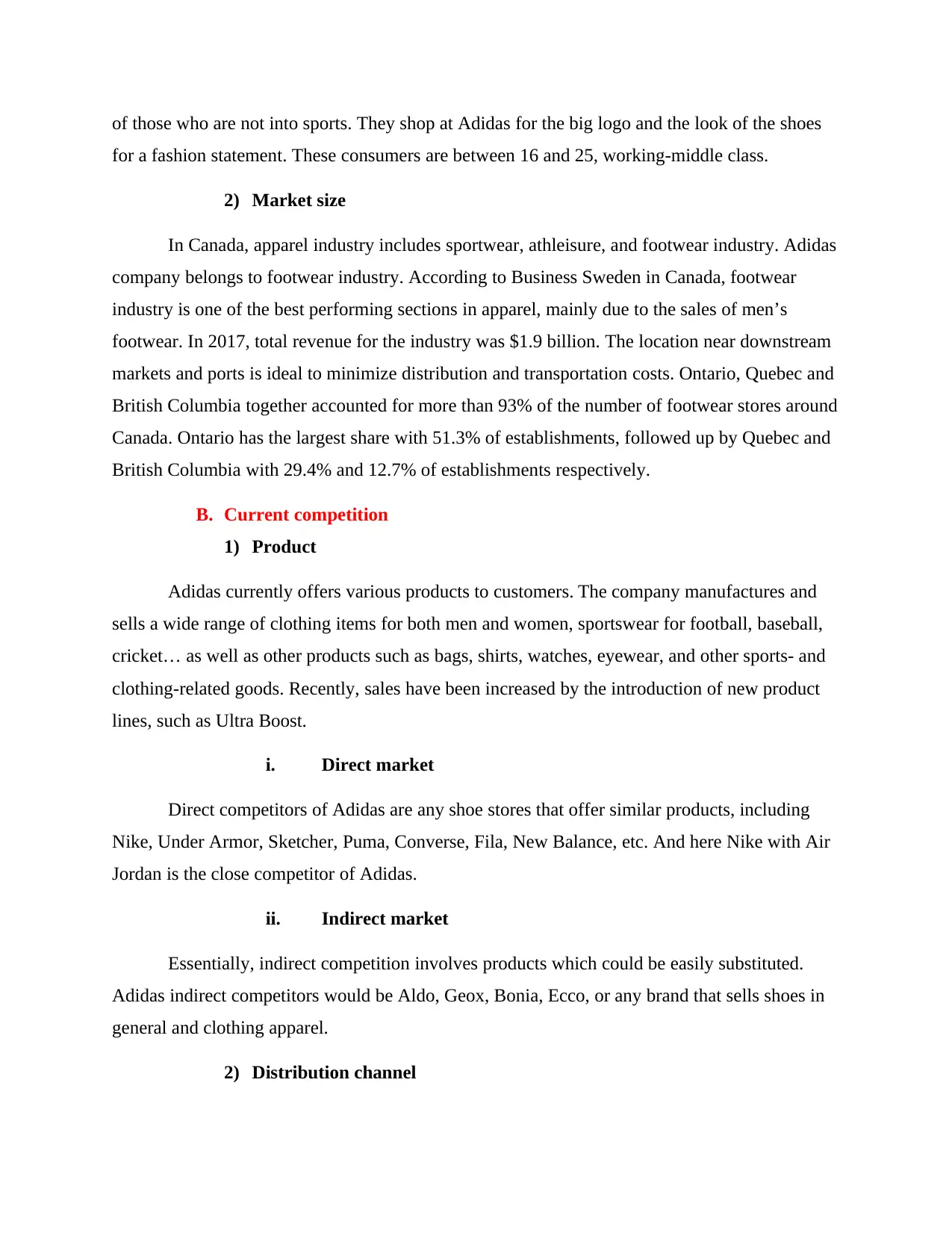
of those who are not into sports. They shop at Adidas for the big logo and the look of the shoes
for a fashion statement. These consumers are between 16 and 25, working-middle class.
2) Market size
In Canada, apparel industry includes sportwear, athleisure, and footwear industry. Adidas
company belongs to footwear industry. According to Business Sweden in Canada, footwear
industry is one of the best performing sections in apparel, mainly due to the sales of men’s
footwear. In 2017, total revenue for the industry was $1.9 billion. The location near downstream
markets and ports is ideal to minimize distribution and transportation costs. Ontario, Quebec and
British Columbia together accounted for more than 93% of the number of footwear stores around
Canada. Ontario has the largest share with 51.3% of establishments, followed up by Quebec and
British Columbia with 29.4% and 12.7% of establishments respectively.
B. Current competition
1) Product
Adidas currently offers various products to customers. The company manufactures and
sells a wide range of clothing items for both men and women, sportswear for football, baseball,
cricket… as well as other products such as bags, shirts, watches, eyewear, and other sports- and
clothing-related goods. Recently, sales have been increased by the introduction of new product
lines, such as Ultra Boost.
i. Direct market
Direct competitors of Adidas are any shoe stores that offer similar products, including
Nike, Under Armor, Sketcher, Puma, Converse, Fila, New Balance, etc. And here Nike with Air
Jordan is the close competitor of Adidas.
ii. Indirect market
Essentially, indirect competition involves products which could be easily substituted.
Adidas indirect competitors would be Aldo, Geox, Bonia, Ecco, or any brand that sells shoes in
general and clothing apparel.
2) Distribution channel
for a fashion statement. These consumers are between 16 and 25, working-middle class.
2) Market size
In Canada, apparel industry includes sportwear, athleisure, and footwear industry. Adidas
company belongs to footwear industry. According to Business Sweden in Canada, footwear
industry is one of the best performing sections in apparel, mainly due to the sales of men’s
footwear. In 2017, total revenue for the industry was $1.9 billion. The location near downstream
markets and ports is ideal to minimize distribution and transportation costs. Ontario, Quebec and
British Columbia together accounted for more than 93% of the number of footwear stores around
Canada. Ontario has the largest share with 51.3% of establishments, followed up by Quebec and
British Columbia with 29.4% and 12.7% of establishments respectively.
B. Current competition
1) Product
Adidas currently offers various products to customers. The company manufactures and
sells a wide range of clothing items for both men and women, sportswear for football, baseball,
cricket… as well as other products such as bags, shirts, watches, eyewear, and other sports- and
clothing-related goods. Recently, sales have been increased by the introduction of new product
lines, such as Ultra Boost.
i. Direct market
Direct competitors of Adidas are any shoe stores that offer similar products, including
Nike, Under Armor, Sketcher, Puma, Converse, Fila, New Balance, etc. And here Nike with Air
Jordan is the close competitor of Adidas.
ii. Indirect market
Essentially, indirect competition involves products which could be easily substituted.
Adidas indirect competitors would be Aldo, Geox, Bonia, Ecco, or any brand that sells shoes in
general and clothing apparel.
2) Distribution channel
⊘ This is a preview!⊘
Do you want full access?
Subscribe today to unlock all pages.

Trusted by 1+ million students worldwide
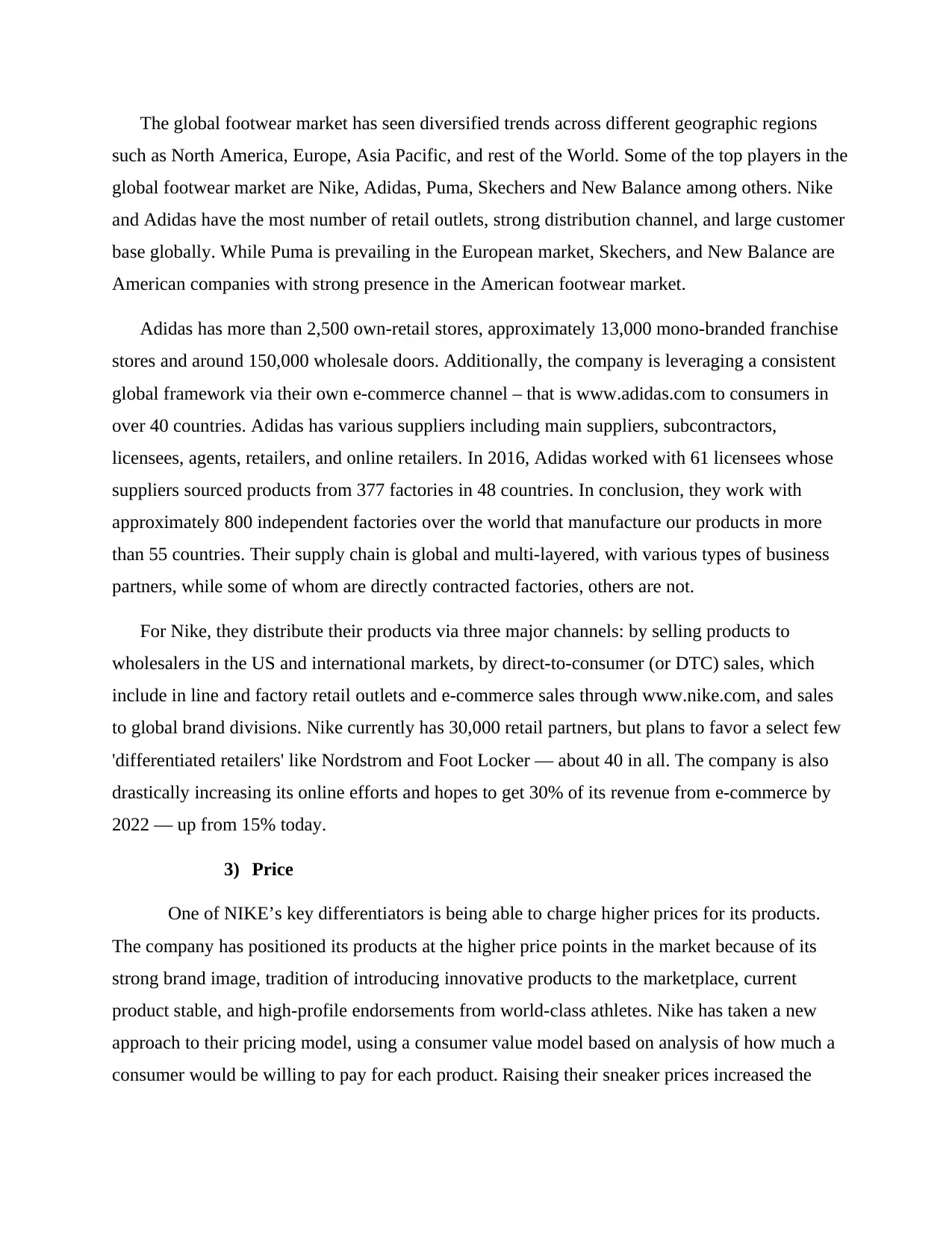
The global footwear market has seen diversified trends across different geographic regions
such as North America, Europe, Asia Pacific, and rest of the World. Some of the top players in the
global footwear market are Nike, Adidas, Puma, Skechers and New Balance among others. Nike
and Adidas have the most number of retail outlets, strong distribution channel, and large customer
base globally. While Puma is prevailing in the European market, Skechers, and New Balance are
American companies with strong presence in the American footwear market.
Adidas has more than 2,500 own-retail stores, approximately 13,000 mono-branded franchise
stores and around 150,000 wholesale doors. Additionally, the company is leveraging a consistent
global framework via their own e-commerce channel – that is www.adidas.com to consumers in
over 40 countries. Adidas has various suppliers including main suppliers, subcontractors,
licensees, agents, retailers, and online retailers. In 2016, Adidas worked with 61 licensees whose
suppliers sourced products from 377 factories in 48 countries. In conclusion, they work with
approximately 800 independent factories over the world that manufacture our products in more
than 55 countries. Their supply chain is global and multi-layered, with various types of business
partners, while some of whom are directly contracted factories, others are not.
For Nike, they distribute their products via three major channels: by selling products to
wholesalers in the US and international markets, by direct-to-consumer (or DTC) sales, which
include in line and factory retail outlets and e-commerce sales through www.nike.com, and sales
to global brand divisions. Nike currently has 30,000 retail partners, but plans to favor a select few
'differentiated retailers' like Nordstrom and Foot Locker — about 40 in all. The company is also
drastically increasing its online efforts and hopes to get 30% of its revenue from e-commerce by
2022 — up from 15% today.
3) Price
One of NIKE’s key differentiators is being able to charge higher prices for its products.
The company has positioned its products at the higher price points in the market because of its
strong brand image, tradition of introducing innovative products to the marketplace, current
product stable, and high-profile endorsements from world-class athletes. Nike has taken a new
approach to their pricing model, using a consumer value model based on analysis of how much a
consumer would be willing to pay for each product. Raising their sneaker prices increased the
such as North America, Europe, Asia Pacific, and rest of the World. Some of the top players in the
global footwear market are Nike, Adidas, Puma, Skechers and New Balance among others. Nike
and Adidas have the most number of retail outlets, strong distribution channel, and large customer
base globally. While Puma is prevailing in the European market, Skechers, and New Balance are
American companies with strong presence in the American footwear market.
Adidas has more than 2,500 own-retail stores, approximately 13,000 mono-branded franchise
stores and around 150,000 wholesale doors. Additionally, the company is leveraging a consistent
global framework via their own e-commerce channel – that is www.adidas.com to consumers in
over 40 countries. Adidas has various suppliers including main suppliers, subcontractors,
licensees, agents, retailers, and online retailers. In 2016, Adidas worked with 61 licensees whose
suppliers sourced products from 377 factories in 48 countries. In conclusion, they work with
approximately 800 independent factories over the world that manufacture our products in more
than 55 countries. Their supply chain is global and multi-layered, with various types of business
partners, while some of whom are directly contracted factories, others are not.
For Nike, they distribute their products via three major channels: by selling products to
wholesalers in the US and international markets, by direct-to-consumer (or DTC) sales, which
include in line and factory retail outlets and e-commerce sales through www.nike.com, and sales
to global brand divisions. Nike currently has 30,000 retail partners, but plans to favor a select few
'differentiated retailers' like Nordstrom and Foot Locker — about 40 in all. The company is also
drastically increasing its online efforts and hopes to get 30% of its revenue from e-commerce by
2022 — up from 15% today.
3) Price
One of NIKE’s key differentiators is being able to charge higher prices for its products.
The company has positioned its products at the higher price points in the market because of its
strong brand image, tradition of introducing innovative products to the marketplace, current
product stable, and high-profile endorsements from world-class athletes. Nike has taken a new
approach to their pricing model, using a consumer value model based on analysis of how much a
consumer would be willing to pay for each product. Raising their sneaker prices increased the
Paraphrase This Document
Need a fresh take? Get an instant paraphrase of this document with our AI Paraphraser
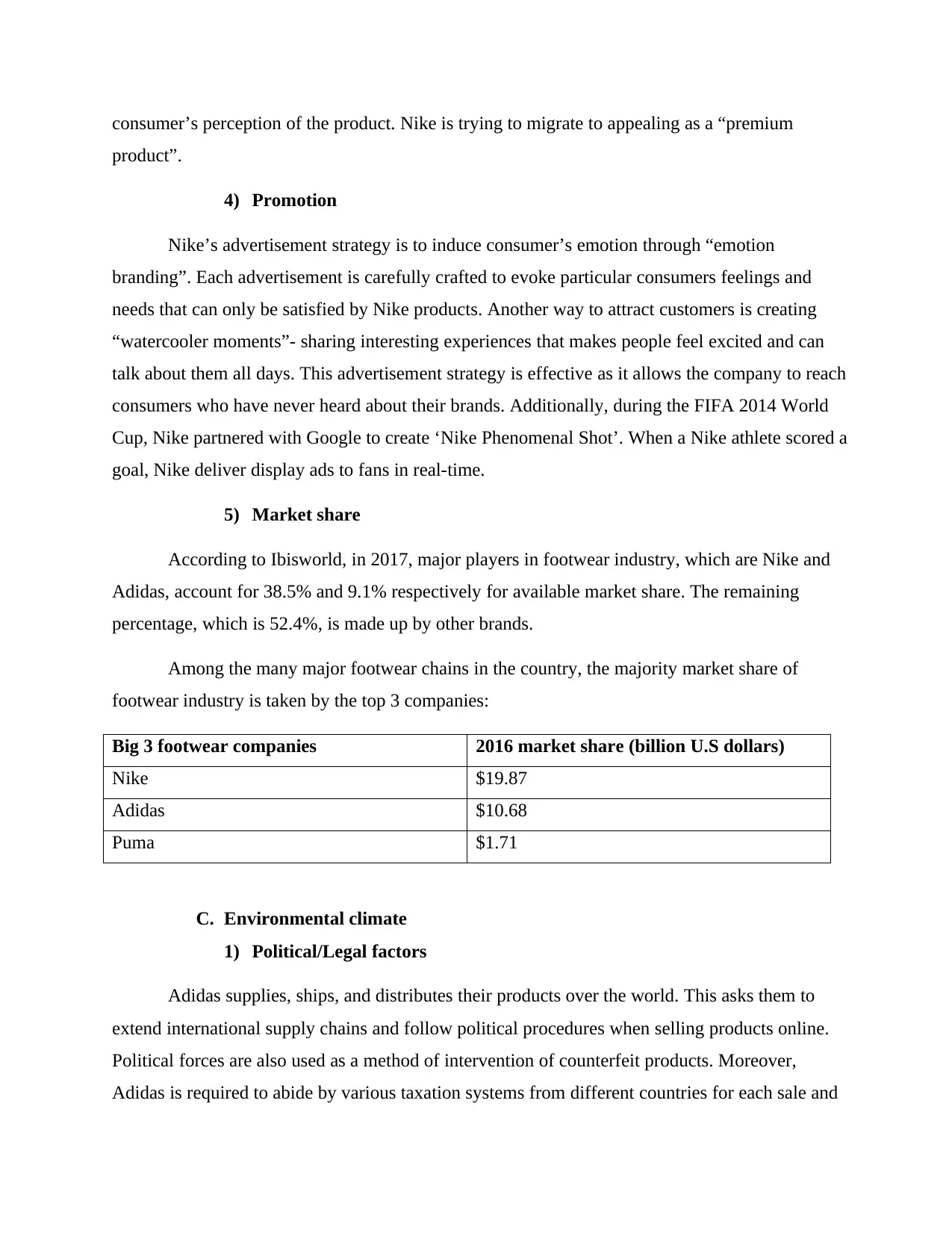
consumer’s perception of the product. Nike is trying to migrate to appealing as a “premium
product”.
4) Promotion
Nike’s advertisement strategy is to induce consumer’s emotion through “emotion
branding”. Each advertisement is carefully crafted to evoke particular consumers feelings and
needs that can only be satisfied by Nike products. Another way to attract customers is creating
“watercooler moments”- sharing interesting experiences that makes people feel excited and can
talk about them all days. This advertisement strategy is effective as it allows the company to reach
consumers who have never heard about their brands. Additionally, during the FIFA 2014 World
Cup, Nike partnered with Google to create ‘Nike Phenomenal Shot’. When a Nike athlete scored a
goal, Nike deliver display ads to fans in real-time.
5) Market share
According to Ibisworld, in 2017, major players in footwear industry, which are Nike and
Adidas, account for 38.5% and 9.1% respectively for available market share. The remaining
percentage, which is 52.4%, is made up by other brands.
Among the many major footwear chains in the country, the majority market share of
footwear industry is taken by the top 3 companies:
Big 3 footwear companies 2016 market share (billion U.S dollars)
Nike $19.87
Adidas $10.68
Puma $1.71
C. Environmental climate
1) Political/Legal factors
Adidas supplies, ships, and distributes their products over the world. This asks them to
extend international supply chains and follow political procedures when selling products online.
Political forces are also used as a method of intervention of counterfeit products. Moreover,
Adidas is required to abide by various taxation systems from different countries for each sale and
product”.
4) Promotion
Nike’s advertisement strategy is to induce consumer’s emotion through “emotion
branding”. Each advertisement is carefully crafted to evoke particular consumers feelings and
needs that can only be satisfied by Nike products. Another way to attract customers is creating
“watercooler moments”- sharing interesting experiences that makes people feel excited and can
talk about them all days. This advertisement strategy is effective as it allows the company to reach
consumers who have never heard about their brands. Additionally, during the FIFA 2014 World
Cup, Nike partnered with Google to create ‘Nike Phenomenal Shot’. When a Nike athlete scored a
goal, Nike deliver display ads to fans in real-time.
5) Market share
According to Ibisworld, in 2017, major players in footwear industry, which are Nike and
Adidas, account for 38.5% and 9.1% respectively for available market share. The remaining
percentage, which is 52.4%, is made up by other brands.
Among the many major footwear chains in the country, the majority market share of
footwear industry is taken by the top 3 companies:
Big 3 footwear companies 2016 market share (billion U.S dollars)
Nike $19.87
Adidas $10.68
Puma $1.71
C. Environmental climate
1) Political/Legal factors
Adidas supplies, ships, and distributes their products over the world. This asks them to
extend international supply chains and follow political procedures when selling products online.
Political forces are also used as a method of intervention of counterfeit products. Moreover,
Adidas is required to abide by various taxation systems from different countries for each sale and
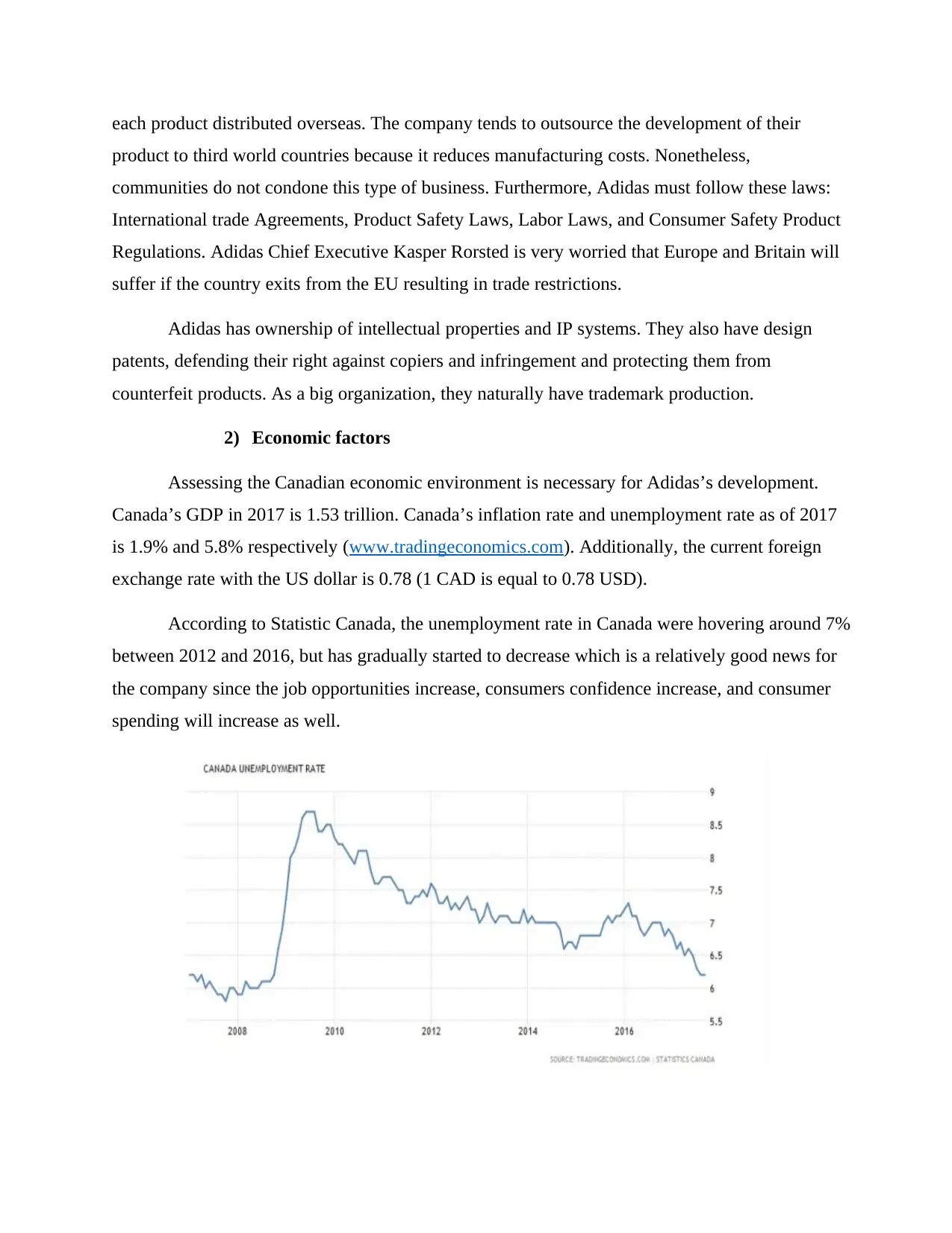
each product distributed overseas. The company tends to outsource the development of their
product to third world countries because it reduces manufacturing costs. Nonetheless,
communities do not condone this type of business. Furthermore, Adidas must follow these laws:
International trade Agreements, Product Safety Laws, Labor Laws, and Consumer Safety Product
Regulations. Adidas Chief Executive Kasper Rorsted is very worried that Europe and Britain will
suffer if the country exits from the EU resulting in trade restrictions.
Adidas has ownership of intellectual properties and IP systems. They also have design
patents, defending their right against copiers and infringement and protecting them from
counterfeit products. As a big organization, they naturally have trademark production.
2) Economic factors
Assessing the Canadian economic environment is necessary for Adidas’s development.
Canada’s GDP in 2017 is 1.53 trillion. Canada’s inflation rate and unemployment rate as of 2017
is 1.9% and 5.8% respectively (www.tradingeconomics.com). Additionally, the current foreign
exchange rate with the US dollar is 0.78 (1 CAD is equal to 0.78 USD).
According to Statistic Canada, the unemployment rate in Canada were hovering around 7%
between 2012 and 2016, but has gradually started to decrease which is a relatively good news for
the company since the job opportunities increase, consumers confidence increase, and consumer
spending will increase as well.
product to third world countries because it reduces manufacturing costs. Nonetheless,
communities do not condone this type of business. Furthermore, Adidas must follow these laws:
International trade Agreements, Product Safety Laws, Labor Laws, and Consumer Safety Product
Regulations. Adidas Chief Executive Kasper Rorsted is very worried that Europe and Britain will
suffer if the country exits from the EU resulting in trade restrictions.
Adidas has ownership of intellectual properties and IP systems. They also have design
patents, defending their right against copiers and infringement and protecting them from
counterfeit products. As a big organization, they naturally have trademark production.
2) Economic factors
Assessing the Canadian economic environment is necessary for Adidas’s development.
Canada’s GDP in 2017 is 1.53 trillion. Canada’s inflation rate and unemployment rate as of 2017
is 1.9% and 5.8% respectively (www.tradingeconomics.com). Additionally, the current foreign
exchange rate with the US dollar is 0.78 (1 CAD is equal to 0.78 USD).
According to Statistic Canada, the unemployment rate in Canada were hovering around 7%
between 2012 and 2016, but has gradually started to decrease which is a relatively good news for
the company since the job opportunities increase, consumers confidence increase, and consumer
spending will increase as well.
⊘ This is a preview!⊘
Do you want full access?
Subscribe today to unlock all pages.

Trusted by 1+ million students worldwide
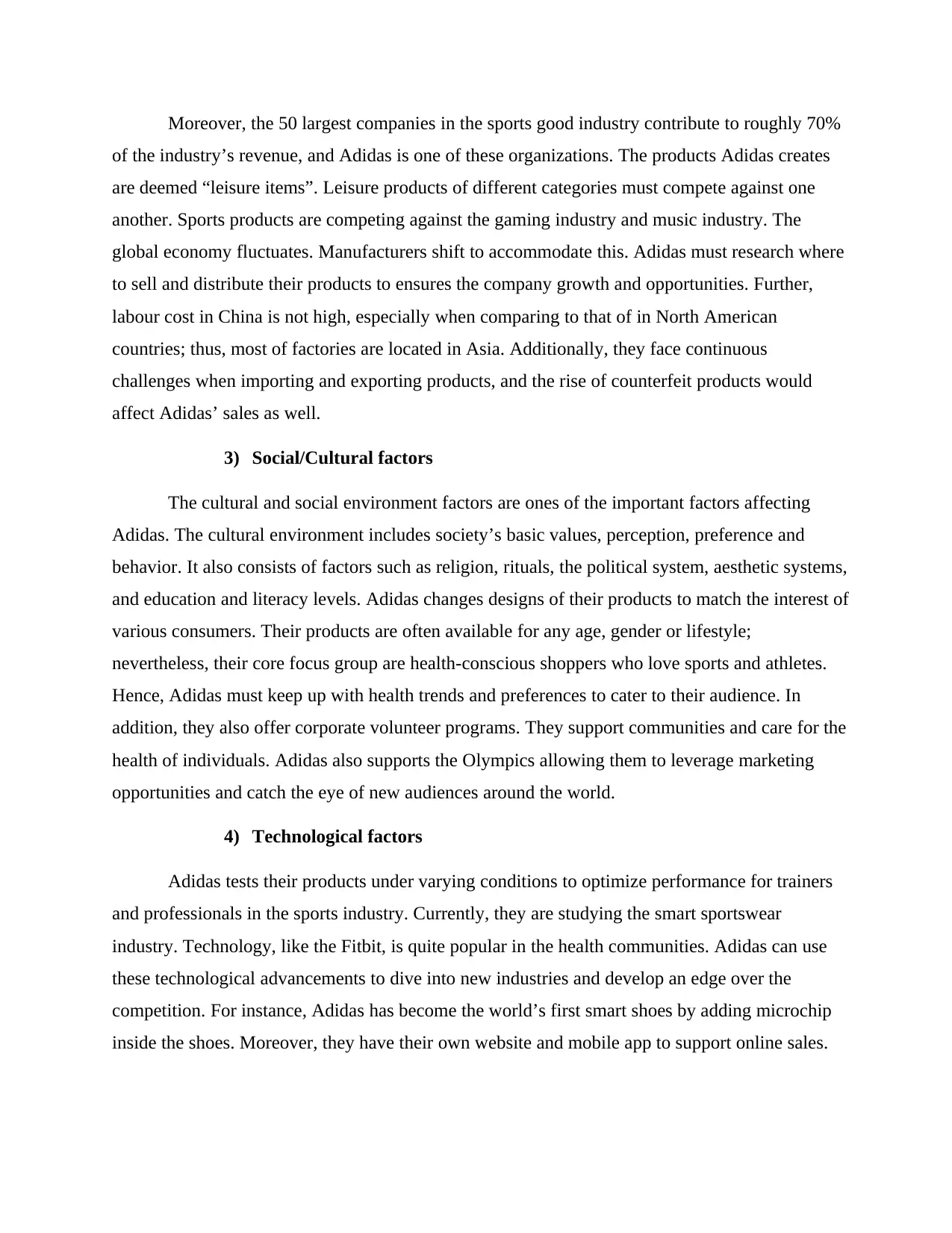
Moreover, the 50 largest companies in the sports good industry contribute to roughly 70%
of the industry’s revenue, and Adidas is one of these organizations. The products Adidas creates
are deemed “leisure items”. Leisure products of different categories must compete against one
another. Sports products are competing against the gaming industry and music industry. The
global economy fluctuates. Manufacturers shift to accommodate this. Adidas must research where
to sell and distribute their products to ensures the company growth and opportunities. Further,
labour cost in China is not high, especially when comparing to that of in North American
countries; thus, most of factories are located in Asia. Additionally, they face continuous
challenges when importing and exporting products, and the rise of counterfeit products would
affect Adidas’ sales as well.
3) Social/Cultural factors
The cultural and social environment factors are ones of the important factors affecting
Adidas. The cultural environment includes society’s basic values, perception, preference and
behavior. It also consists of factors such as religion, rituals, the political system, aesthetic systems,
and education and literacy levels. Adidas changes designs of their products to match the interest of
various consumers. Their products are often available for any age, gender or lifestyle;
nevertheless, their core focus group are health-conscious shoppers who love sports and athletes.
Hence, Adidas must keep up with health trends and preferences to cater to their audience. In
addition, they also offer corporate volunteer programs. They support communities and care for the
health of individuals. Adidas also supports the Olympics allowing them to leverage marketing
opportunities and catch the eye of new audiences around the world.
4) Technological factors
Adidas tests their products under varying conditions to optimize performance for trainers
and professionals in the sports industry. Currently, they are studying the smart sportswear
industry. Technology, like the Fitbit, is quite popular in the health communities. Adidas can use
these technological advancements to dive into new industries and develop an edge over the
competition. For instance, Adidas has become the world’s first smart shoes by adding microchip
inside the shoes. Moreover, they have their own website and mobile app to support online sales.
of the industry’s revenue, and Adidas is one of these organizations. The products Adidas creates
are deemed “leisure items”. Leisure products of different categories must compete against one
another. Sports products are competing against the gaming industry and music industry. The
global economy fluctuates. Manufacturers shift to accommodate this. Adidas must research where
to sell and distribute their products to ensures the company growth and opportunities. Further,
labour cost in China is not high, especially when comparing to that of in North American
countries; thus, most of factories are located in Asia. Additionally, they face continuous
challenges when importing and exporting products, and the rise of counterfeit products would
affect Adidas’ sales as well.
3) Social/Cultural factors
The cultural and social environment factors are ones of the important factors affecting
Adidas. The cultural environment includes society’s basic values, perception, preference and
behavior. It also consists of factors such as religion, rituals, the political system, aesthetic systems,
and education and literacy levels. Adidas changes designs of their products to match the interest of
various consumers. Their products are often available for any age, gender or lifestyle;
nevertheless, their core focus group are health-conscious shoppers who love sports and athletes.
Hence, Adidas must keep up with health trends and preferences to cater to their audience. In
addition, they also offer corporate volunteer programs. They support communities and care for the
health of individuals. Adidas also supports the Olympics allowing them to leverage marketing
opportunities and catch the eye of new audiences around the world.
4) Technological factors
Adidas tests their products under varying conditions to optimize performance for trainers
and professionals in the sports industry. Currently, they are studying the smart sportswear
industry. Technology, like the Fitbit, is quite popular in the health communities. Adidas can use
these technological advancements to dive into new industries and develop an edge over the
competition. For instance, Adidas has become the world’s first smart shoes by adding microchip
inside the shoes. Moreover, they have their own website and mobile app to support online sales.
Paraphrase This Document
Need a fresh take? Get an instant paraphrase of this document with our AI Paraphraser
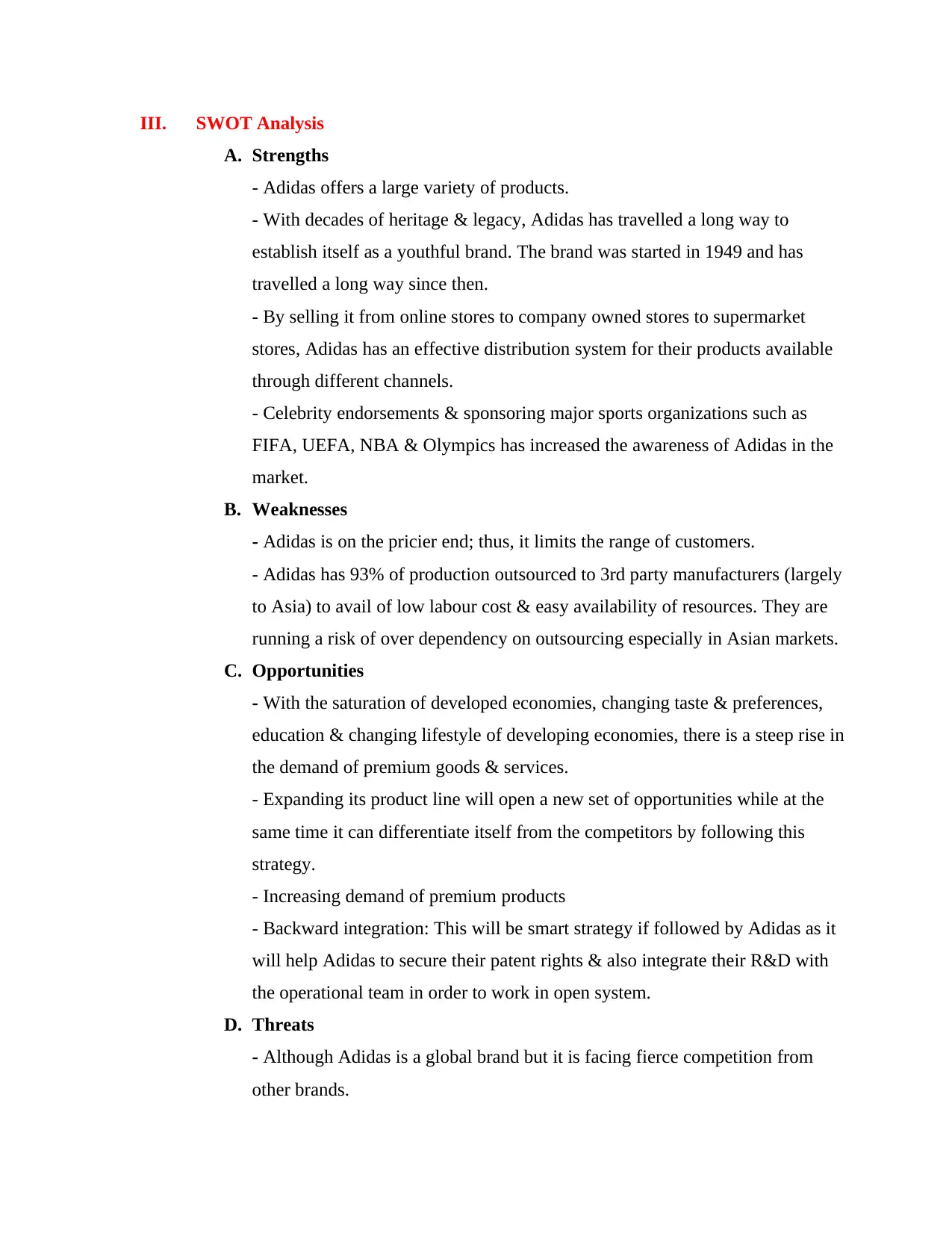
III. SWOT Analysis
A. Strengths
- Adidas offers a large variety of products.
- With decades of heritage & legacy, Adidas has travelled a long way to
establish itself as a youthful brand. The brand was started in 1949 and has
travelled a long way since then.
- By selling it from online stores to company owned stores to supermarket
stores, Adidas has an effective distribution system for their products available
through different channels.
- Celebrity endorsements & sponsoring major sports organizations such as
FIFA, UEFA, NBA & Olympics has increased the awareness of Adidas in the
market.
B. Weaknesses
- Adidas is on the pricier end; thus, it limits the range of customers.
- Adidas has 93% of production outsourced to 3rd party manufacturers (largely
to Asia) to avail of low labour cost & easy availability of resources. They are
running a risk of over dependency on outsourcing especially in Asian markets.
C. Opportunities
- With the saturation of developed economies, changing taste & preferences,
education & changing lifestyle of developing economies, there is a steep rise in
the demand of premium goods & services.
- Expanding its product line will open a new set of opportunities while at the
same time it can differentiate itself from the competitors by following this
strategy.
- Increasing demand of premium products
- Backward integration: This will be smart strategy if followed by Adidas as it
will help Adidas to secure their patent rights & also integrate their R&D with
the operational team in order to work in open system.
D. Threats
- Although Adidas is a global brand but it is facing fierce competition from
other brands.
A. Strengths
- Adidas offers a large variety of products.
- With decades of heritage & legacy, Adidas has travelled a long way to
establish itself as a youthful brand. The brand was started in 1949 and has
travelled a long way since then.
- By selling it from online stores to company owned stores to supermarket
stores, Adidas has an effective distribution system for their products available
through different channels.
- Celebrity endorsements & sponsoring major sports organizations such as
FIFA, UEFA, NBA & Olympics has increased the awareness of Adidas in the
market.
B. Weaknesses
- Adidas is on the pricier end; thus, it limits the range of customers.
- Adidas has 93% of production outsourced to 3rd party manufacturers (largely
to Asia) to avail of low labour cost & easy availability of resources. They are
running a risk of over dependency on outsourcing especially in Asian markets.
C. Opportunities
- With the saturation of developed economies, changing taste & preferences,
education & changing lifestyle of developing economies, there is a steep rise in
the demand of premium goods & services.
- Expanding its product line will open a new set of opportunities while at the
same time it can differentiate itself from the competitors by following this
strategy.
- Increasing demand of premium products
- Backward integration: This will be smart strategy if followed by Adidas as it
will help Adidas to secure their patent rights & also integrate their R&D with
the operational team in order to work in open system.
D. Threats
- Although Adidas is a global brand but it is facing fierce competition from
other brands.
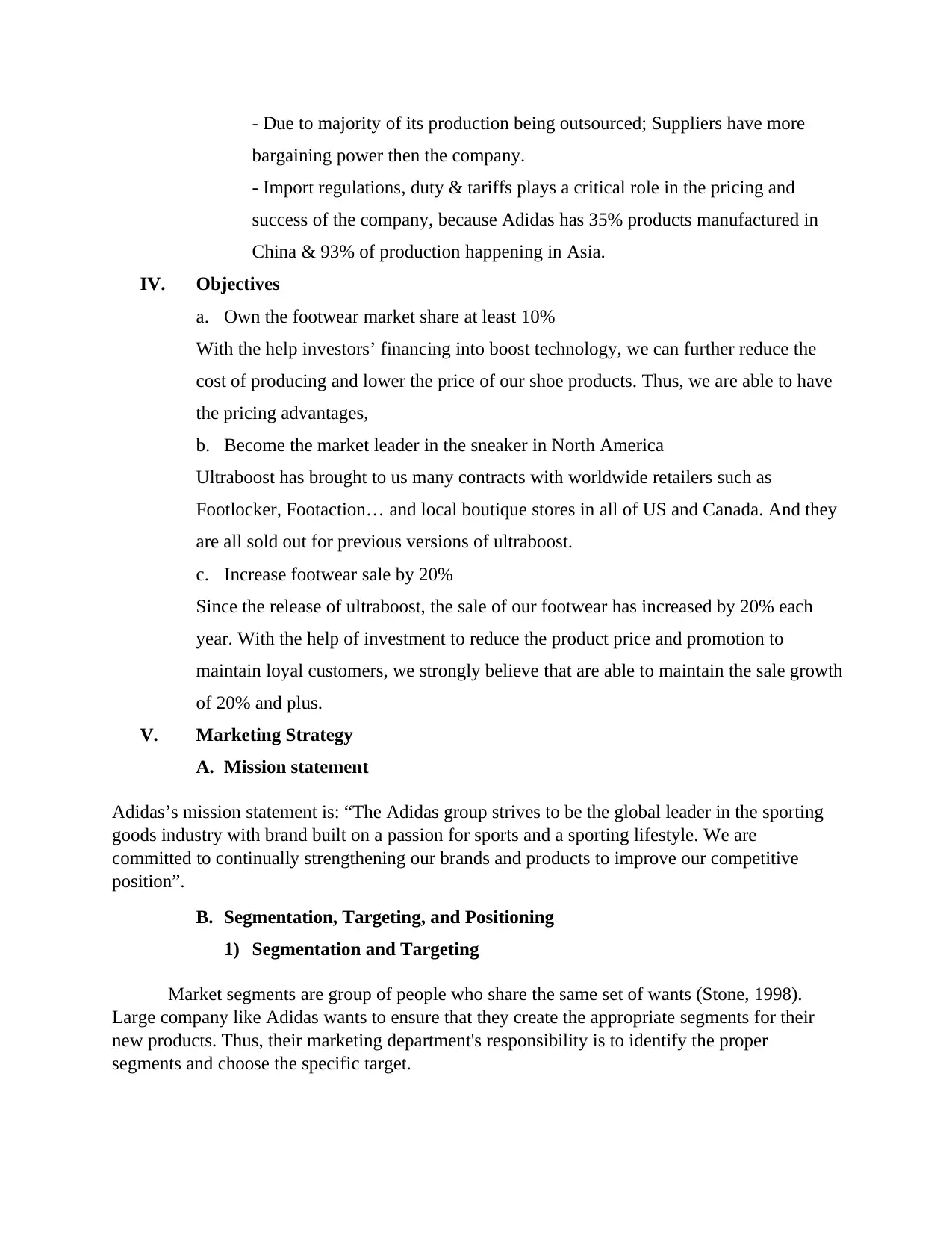
- Due to majority of its production being outsourced; Suppliers have more
bargaining power then the company.
- Import regulations, duty & tariffs plays a critical role in the pricing and
success of the company, because Adidas has 35% products manufactured in
China & 93% of production happening in Asia.
IV. Objectives
a. Own the footwear market share at least 10%
With the help investors’ financing into boost technology, we can further reduce the
cost of producing and lower the price of our shoe products. Thus, we are able to have
the pricing advantages,
b. Become the market leader in the sneaker in North America
Ultraboost has brought to us many contracts with worldwide retailers such as
Footlocker, Footaction… and local boutique stores in all of US and Canada. And they
are all sold out for previous versions of ultraboost.
c. Increase footwear sale by 20%
Since the release of ultraboost, the sale of our footwear has increased by 20% each
year. With the help of investment to reduce the product price and promotion to
maintain loyal customers, we strongly believe that are able to maintain the sale growth
of 20% and plus.
V. Marketing Strategy
A. Mission statement
Adidas’s mission statement is: “The Adidas group strives to be the global leader in the sporting
goods industry with brand built on a passion for sports and a sporting lifestyle. We are
committed to continually strengthening our brands and products to improve our competitive
position”.
B. Segmentation, Targeting, and Positioning
1) Segmentation and Targeting
Market segments are group of people who share the same set of wants (Stone, 1998).
Large company like Adidas wants to ensure that they create the appropriate segments for their
new products. Thus, their marketing department's responsibility is to identify the proper
segments and choose the specific target.
bargaining power then the company.
- Import regulations, duty & tariffs plays a critical role in the pricing and
success of the company, because Adidas has 35% products manufactured in
China & 93% of production happening in Asia.
IV. Objectives
a. Own the footwear market share at least 10%
With the help investors’ financing into boost technology, we can further reduce the
cost of producing and lower the price of our shoe products. Thus, we are able to have
the pricing advantages,
b. Become the market leader in the sneaker in North America
Ultraboost has brought to us many contracts with worldwide retailers such as
Footlocker, Footaction… and local boutique stores in all of US and Canada. And they
are all sold out for previous versions of ultraboost.
c. Increase footwear sale by 20%
Since the release of ultraboost, the sale of our footwear has increased by 20% each
year. With the help of investment to reduce the product price and promotion to
maintain loyal customers, we strongly believe that are able to maintain the sale growth
of 20% and plus.
V. Marketing Strategy
A. Mission statement
Adidas’s mission statement is: “The Adidas group strives to be the global leader in the sporting
goods industry with brand built on a passion for sports and a sporting lifestyle. We are
committed to continually strengthening our brands and products to improve our competitive
position”.
B. Segmentation, Targeting, and Positioning
1) Segmentation and Targeting
Market segments are group of people who share the same set of wants (Stone, 1998).
Large company like Adidas wants to ensure that they create the appropriate segments for their
new products. Thus, their marketing department's responsibility is to identify the proper
segments and choose the specific target.
⊘ This is a preview!⊘
Do you want full access?
Subscribe today to unlock all pages.

Trusted by 1+ million students worldwide
1 out of 19
Related Documents
Your All-in-One AI-Powered Toolkit for Academic Success.
+13062052269
info@desklib.com
Available 24*7 on WhatsApp / Email
![[object Object]](/_next/static/media/star-bottom.7253800d.svg)
Unlock your academic potential
Copyright © 2020–2025 A2Z Services. All Rights Reserved. Developed and managed by ZUCOL.




